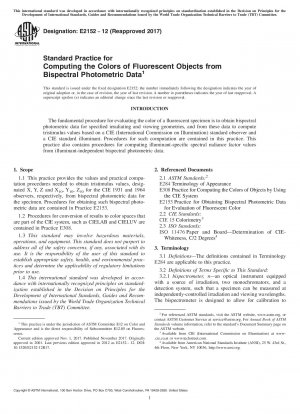ASTM E2152-12(2017)
Standard Practice for Computing the Colors of Fluorescent Objects from Bispectral Photometric Data
- Standard No.
- ASTM E2152-12(2017)
- Release Date
- 2012
- Published By
- American Society for Testing and Materials (ASTM)
- Status
- Replace By
- ASTM E2152-12(2023)
- Latest
- ASTM E2152-12(2023)
- Scope
-
5.1 The bispectral or two-monochromator method is the definitive method for the determination of the general radiation-transfer properties of fluorescent specimens (2). In this method, the measuring instrument is equipped with two separate monochromators. The first, the irradiation monochromator, irradiates the specimen with monochromatic light. The second, the viewing monochromator, analyzes the radiation leaving the specimen. A two-dimensional array of bispectral photometric values is obtained by setting the irradiation monochromator at a series of fixed wavelengths (μ) in the ultraviolet and visible range, and for each μ, using the viewing monochromator to record readings for each wavelength (λ) in the visible range. The resulting array, once properly corrected, is known as the Donaldson matrix, and the value of each element (μ,λ) of this array is here described as the Donaldson radiance factor (D(μ,λ)). The Donaldson radiance factor is an instrument- and illuminant-independent photometric property of the specimen, and can be used to calculate its color for any desired illuminant and observer. The advantage of this method is that it provides a comprehensive characterization of the specimen’s radiation-transfer properties, without the inaccuracies associated with source simulation and various methods of approximation.
1.1 This practice provides the values and practical computation procedures needed to obtain tristimulus values, designated X, Y, Z and X10, Y10, Z10 for the CIE 1931 and 1964 observers, respectively, from bispectral photometric data for the specimen. Procedures for obtaining such bispectral photometric data are contained in Practice E2153.
1.2 Procedures for conversion of results to color spaces that are part of the CIE system, such as CIELAB and CIELUV are contained in Practice E308.
1.3 This standard may involve hazardous materials, operations, and equipment. This standard does not purport to address all of the safety concerns, if any, associated with its use. It is the responsibility of the user of this standard to establish appropriate safety, health, and environmental practices and determine the applicability of regulatory limitations prior to use.
1.4 This international standard was developed in accordance with internationally recognized principles on standardization established in the Decision on Principles for the Development of International Standards, Guides and Recommendations issued by the World Trade Organization Technical Barriers to Trade (TBT) Committee.
ASTM E2152-12(2017) Referenced Document
- ASTM E2153 Standard Practice for Obtaining Bispectral Photometric Data for Evaluation of Fluorescent Color
- ASTM E284 Standard Terminology of Appearance
- ASTM E308 Standard Practice for Computing the Colors of Objects by Using the CIE System
- ISO 11476 Paper and board - Determination of CIE whiteness, C/2° (indoor illumination conditions)
ASTM E2152-12(2017) history
- 2023 ASTM E2152-12(2023) Standard Practice for Computing the Colors of Fluorescent Objects from Bispectral Photometric Data
- 2012 ASTM E2152-12(2017) Standard Practice for Computing the Colors of Fluorescent Objects from Bispectral Photometric Data
- 2012 ASTM E2152-12 Standard Practice for Computing the Colors of Fluorescent Objects from Bispectral Photometric Data
- 2001 ASTM E2152-01(2006) Standard Practice for Computing the Colors of Fluorescent Objects from Bispectral Photometric Data
- 2001 ASTM E2152-01 Standard Practice for Computing the Colors of Fluorescent Objects from Bispectral Photometric Data
